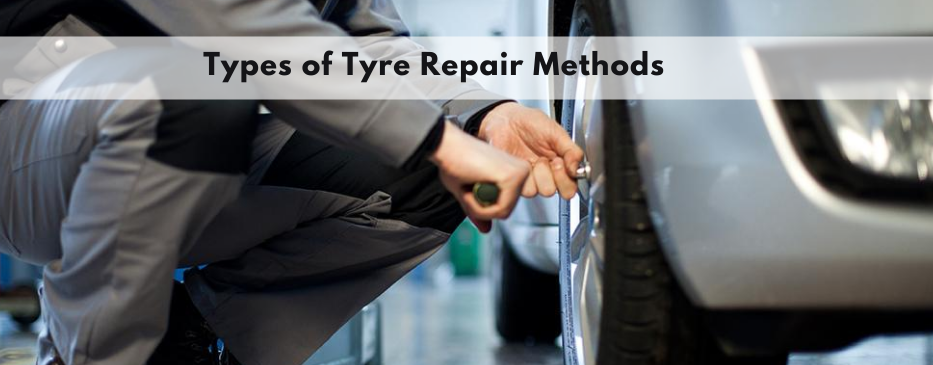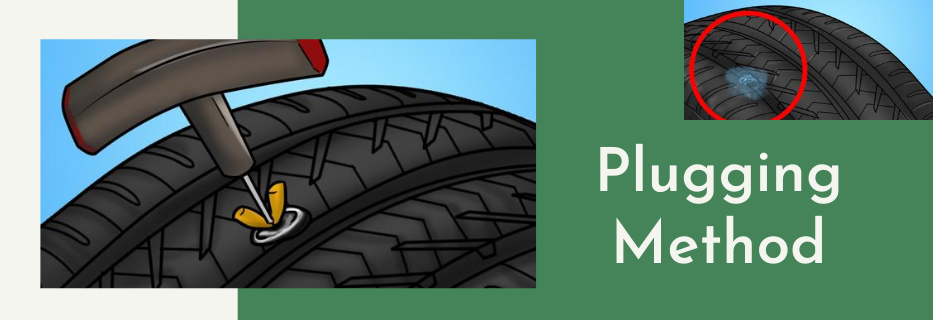Well, a flat tyre must ideally be changed, but it may be possible to repair it. A flat tyre can be repaired in three different ways’ viz. (1) Simple Plugging, (2) Patching and (3) Plug/Patch Combination.
Method #1: Simple Plugging to Repair a Flat Tyre
A simple plug is the easiest and quickest ways to repair a flat tyre. The mechanic makes a plug with a small piece of leather and coat it using rubber adhesive, and finally plug the puncture with it. When you drive your vehicle on the repaired tyre, the heat is produced to treat the rubber adhesive and it solidifies to seal the puncture. This repair can be done without removing the tyre.
There is also a disadvantage for this type of quick tyre repair. The plug must have the same shape and fit precisely — that means an oddly shaped hole will be tough to plug. The plug may get loose on its own, and the repair could fail.
Method #2: Patching to Repair a Flat Tyre
The internal repair method is known as patching. Inside the tyre, a rubber square supported with rubber adhesive is glued to the puncture. As you drive your vehicle, the tyre heats up, the adhesive vulcanises and hardens the repair.
As the tyre needs to be removed from the vehicle, this type of repair takes more time and is costlier than the plugging method but is more stable.
Method #3: Combining Plug & Patch to Repair a Flat Tyre
Combining plug and patch is the most reliable of the three tyre repair methods. It is referred also as the mushroom repair method, which seals the puncture from inside to the outside. A tail is attached to the rubber patch and weaved through the puncture hole to work as the plug.
The flat tyre must be removed to repair using a combined plug and patch method. This method is the most effective out of the three and the most complicated as well. Besides, it takes more time than the other two methods and is the costliest.
How Is a Flat Tyre Repair Done with Plug & Patch Method?
Plug & patch tyre repair is an intricate method involving a strict procedure that needs to be followed.
- First, remove the tyre and check thoroughly to ensure it’s repairable
- The damage must be located and properly marked. Remove foreign objects that might have stuck inside.
- The puncture-hole should be drilled from the tyre’s inside to make it consistent.
- Next, the puncture is also drilled from the outside till no resistance is felt.
- The damaged area should be cleaned thoroughly covering around 1 to 2 cm more than the size of the repair-patch that uses a repair scraper and pre-buff cleaners.
- On tyre’s inside, the patch is held where it will be repaired, and around the repair-patch, the tyre is marked up. The marked area is then buffed to around ½ cm bigger than the repair-patch with a domed buffing rasp (Note: The area must be flat).
- Remove all dust, the repair area must be clean and shouldn’t contain wire or fluffed cords.
- The puncture groove and the buffed patch-area is reinforced with a vulcanising accelerator.
- Time to plug the puncture — the patch’s tail is weaved all through the puncture hole.
- From the tyre’s outside, the tail is pulled, so the patch rests tight and flushes internally.
- Using a corrugated tyre stitcher, the patch is spin around from its centre to its edges. It causes eliminating air bubbles and ensure full contact with the buffed tyre interior.
- The repair-patch and plug-base are sealed with an inner liner sealant.
- The tyre is fitted onto the wheel and filled up with the right pressure.
- Finally, the plug is cut to level it with the tyre’s tread. The tyre repair is complete!
Do You Need Tyre Repair Service in Sydney?
Touch base with Eagle Tyres, the most trusted tyre shop in Sydney! We sell premium tyres of the choicest brands such as Bridgestone, Achilles Radial, Continental, Atturo, BF Goodrich, Dunlop, Good Year etc. Besides, we provide valuable services such as puncture and tyre repair, wheel balancing and alignment etc. Moreover, you can also directly buy tyres online from our website at attractive prices.
Summing Up
Well, you can get a flat tyre repair using three different methods. The plug and patch combination method is the most stable out of the three. However, depending upon the damage done to a tyre, a tyre expert will recommend the best-suited method after thorough tyre inspection. Usually, for milder-damage, 1st (plugging) and 2nd (patching) are good to go; however, for grave damage, 3rd (plug and patch combination) method is usually done. When a flat tyre is beyond repairs, a brand-new replacement tyre must be fit for the safety of you and your family.
Tyres & wheels are the most valuable parts of your vehicle, so its better to be safe than sorry!







